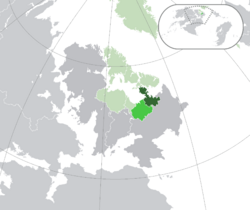East Ruthen
This article is incomplete because it is pending further input from participants, or it is a work-in-progress by one author. Please comment on this article's talk page to share your input, comments and questions. Note: To contribute to this article, you may need to seek help from the author(s) of this page. |
Republic of Ruthen Republik Ruthen (Ruthish) | |
|---|---|
Coat of arms
| |
| Motto: Du schönstes Land von Uns ("Thou fairest land of ours") | |
| Anthem: "Einheitshymne" "Unity Hymn" | |
 Territory controlled | |
| Capital and largest city | Sagard |
| Official languages | Ruthish Ruthish Sign Language |
| Ethnic groups (2021) | 88.9% Ruthish 11.1% other |
| Religion (2021) | 65.8% Gregorianism 29.7% Irreligious 4.5% Others |
| Demonym(s) | East Ruthish · Ruthish |
| Government | Unitary parliamentary republic |
| Johanna Kohnstamm | |
| Rebecca Blankenburg | |
| Stephen Waldschmidt | |
| Legislature | Staatsrat |
| Establishment | |
| 9 December 987 | |
| 9 September 1438 | |
| 27 February 1862 | |
| 28 November 1864 | |
| 14 July 1943 | |
| 24 December 1944 | |
| 24 November 2000 | |
| Area | |
• Total | 122,148 km2 (47,162 sq mi) |
• Water (%) | 1.1 |
| Population | |
• 2023 estimate | |
• 2021 census | |
• Density | 150.492/km2 (389.8/sq mi) |
| GDP (PPP) | 2021 estimate |
• Total | |
• Per capita | |
| GDP (nominal) | 2021 estimate |
• Total | |
• Per capita | |
| Gini (2020) | medium |
| HDI (2022) | very high |
| Currency | Ruthische Mark (ʀ̩) (ERM) |
| Time zone | UTC+1 (East Calesian Time, ECT) |
• Summer (DST) | UTC+2 (East Calesian Summer Time, ECST) |
| Date format | dd-mm-yy |
| Driving side | left |
| Calling code | +24 |
| Internet TLD | .rr |
East Ruthen (Ruthish: Ost-Ruthen), officially the Ruthish Republic (RR; Ruthish: Republik Ruthen: RVR), is a sovereign country in Central Calesia. The country's northern border is defined by its coastline on Swarin Sea and the Selenter straits. To the east and south it borders Undefinedland whilst in the west it shares a border with West Ruthen along the Ruthish Demilitarised Zone, although it claims sovereignty over the entirety of West Ruthen as the sole legitimate Ruthish government and thus claims to share land borders with Dahemia, Dutchland, and Hyacinthe in the west. East Ruthen has a population of 17.74 million and occupies a total area of 122,148 km2 (47,162 sq mi) and has a considerably lower population density than many of its neighbours at 150.492/km2 (389.77/sq mi). Its capital and largest city is Sagard am Möhne which is the only city in East Ruthen with an urban population in excess of 800 thousand. Other urban areas in the country include Jübek, Waren, Penkun, Leezen and Staßfurt.
The area encompassing greater Ruthen has been inhabited since the Paleolithic era and from the Neolithic era by various Celts and later Waldic tribes in the north of the country. The area to the south of the Hunsrück river which today forms the boundary between East and West Ruthen fell under the control of the Hernician Empire who first named the area Maior Ruthenia. After the fall of the Hernician Empire by tribes such as the Ruthenii, various Waldic states emerged before eventually being united into the first North Ruthenic Kingdom. Ruthen enjoyed a period of relative stability until the Catabolic Crisis which saw the collapse of the North Ruthenic Kingdom in 1355. The subsequent Ninety Years' War and the Peace of Sallahn led to the creation of the Ruthish Confederation which saw Ruthen re-emerge as a major power in North Central Calesia albeit as a loose confederation of several dozen independent states. During the !Reformation, the Ruthish Confederation was divided on religious lines with the northern and coastal regions falling under the influence of states loyal to the Northern Cathedralist Church whilst states more central in the Confederation remained loyal to the Presterist church.
The Renaissance in the 17th century allowed for the development of liberal and pan-Ruthenic thought, advancements in technology and communication also allowed these ideas to spread more rapidly throughout the Confederation. The Twelve Years' War and Elizabeth Square Declaration in Falland were the catalysts for events in Ruthen as liberal bourgeois revolutionaries were able to seize swathes of territory. The Thessen Parliament in February 1862 saw the first Ruthish Constitution adopted by Radical and Liberal politicians and the establishment of the constitutional Kingdom of Ruthen in 1864 after the War of Ruthish Unification. Ruthen was a key colonial power during the late 19th century, openly pursuing the creation and expansion of overseas colonial holdings culminating in the establishment of one of the largest Calesian empires at the time. In the late 19th and early 20th centuries, Ruthen became deeply politically divided between the emerging socialist parties and the governing liberal parties which sparked the Roter Sommer in 1923.
East Ruthen traces its political legitimacy to the actions of the Staatsrat's emergency interim government in the closing days of the Great War and the shortlived Ruthish Republic in 1940 prior to the Ruthish surrender to the Transmedan Powers. East Ruthen was formed on 24 December 1944 in the midst of the Ruthish Crisis with external support from Waldrich after a period of Transmedan occupation. East Ruthen initially struggled to gain political or social legitimacy as a state and failed to be recognised by several nations for the majority of the 20th century; the period of Grenzpolitik pursued by both Ruthish governments allowed for East Ruthen to secure legitimacy as a sovereign nation. However, in the late 20th century, East Ruthen enjoyed a period of political and economic stability as well as warmer inter-Rutish ties as a result of Grenzpolitik. In July 1999, after a period of worsening relations, West Ruthen invaded East Ruthen, sparking the Six-Day War and the establishment of the Ruthish Demilitarised Zone and the United Congress Monitoring Authority for Ruthen (UCMAR); no formal peace treaty has ever been signed. The Six-Day War allowed for East Ruthen to secure international support and secure its position as a member of the international community.
East Ruthen is a unitary parliamentary republic with a directly elected Staatsrat with an indirectly elected President as head of state and a Minister-President as head of government. East Ruthen has a high nominal GDP per capita as well as a high rank of the Human Development Index. It has been a member state of the United Congress since 2001 which it joined alongside West Ruthen as part of the Inter-Ruthish peace process. Since 2005 it has also been a full member of the Nordbund.
Etymology
History
Prehistory
Hernician era
North Ruthenic Kingdom
Ruthish Confederation
Reformation
Emergence of nationalism
Kingdom of Ruthen
Great War and occupation of Ruthen
Ruthish Republic
Diplomatic isolation and social illegitimacy
Grenzpolitik
Six-Day War
Contemporary history
Geography
Climate
Biodiversity
Government and politics
 |
|
Government (83) Ruthen Peasants Party (40) Democratic Party (29) Progress Party (14) Opposition (60) Social Democrats (36) Gregorian Democratic Union (16) Radical Social Liberal Party (4) Pirate Party (4) |





